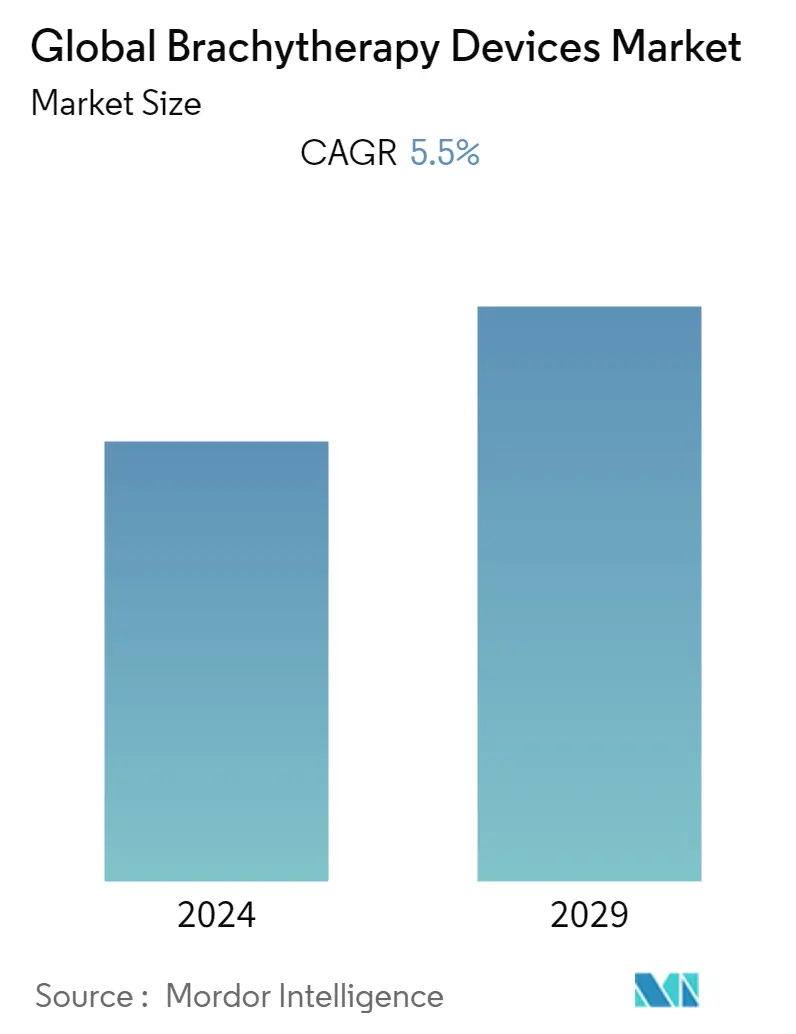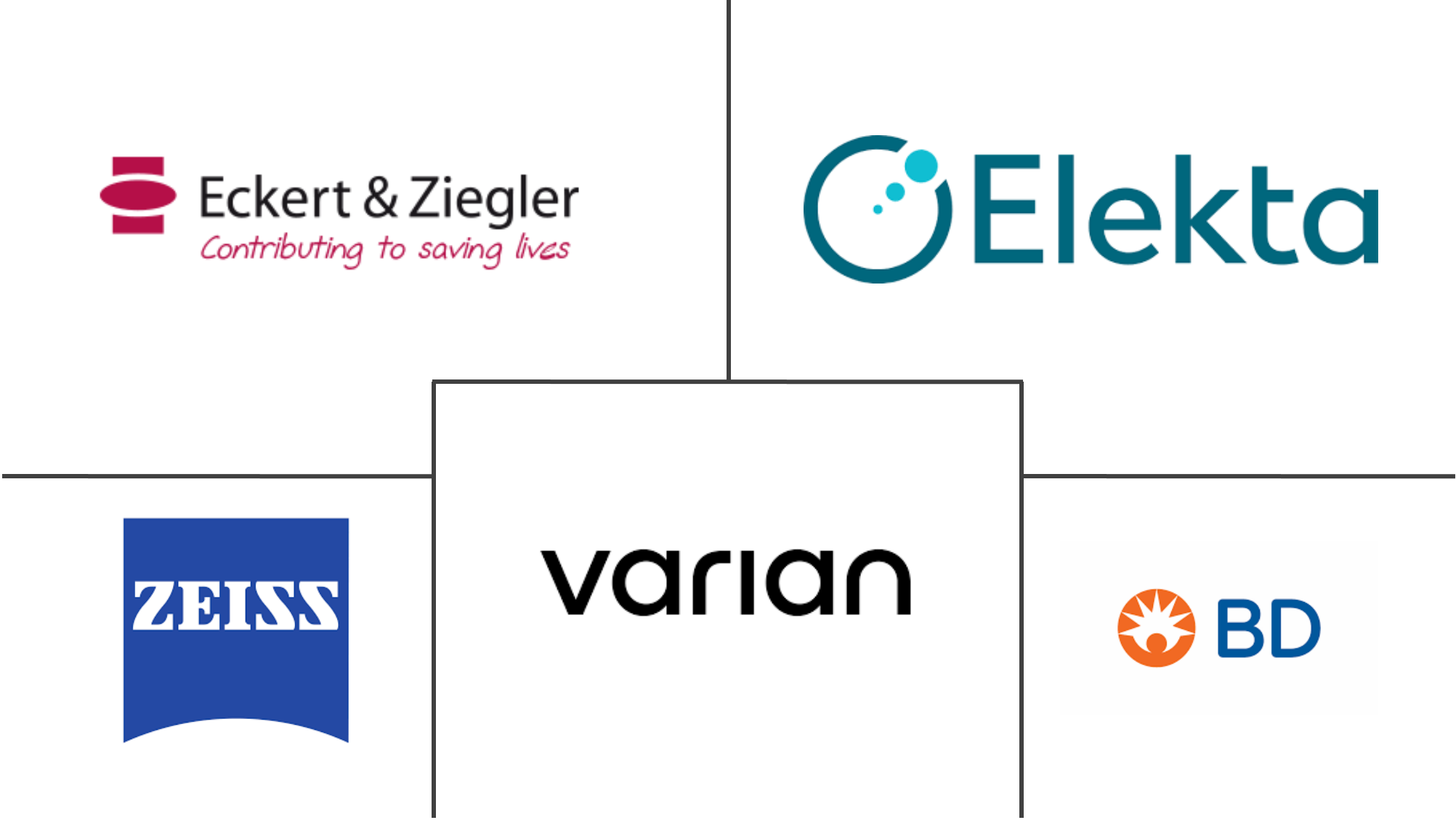Market Size of Global Brachytherapy Devices Industry

| Study Period | 2019 - 2029 |
| Base Year For Estimation | 2023 |
| Forecast Data Period | 2024 - 2029 |
| CAGR | 5.50 % |
| Fastest Growing Market | Asia Pacific |
| Largest Market | North America |
Major Players
*Disclaimer: Major Players sorted in no particular order |
Brachytherapy Devices Market Analysis
The brachytherapy devices market is projected to register a CAGR of 5.5% during the forecast period (2022-2027).
The COVID-19 pandemic has affected the healthcare systems globally and also has had a significant impact on the Brachytherapy devices market. As per the article published in Cancer Connect 2020, A total of 7 patients with prostate cancer who were scheduled to receive brachytherapy were treated across the 4 hospitals. However, only 3 patients (43%) were able to undergo brachytherapy. As per the study published in January 2021, titled 'The Impact of COVID-19 on Brachytherapy During the Pandemic: A Rutgers-Robert Wood Johnson Barnabas Health Multisite Experience', by advances in radiation oncology, six patients elected to undergo EBRT followed by a brachytherapy boost for unfavorable intermediate- and high-risk diseases and since elective surgeries were canceled within the system during the pandemic, 4 patients were treated with EBRT with or without androgen deprivation therapy (ADT) only. Despite the challenges, the health care system faced during the pandemic, most patients with cancer were safely treated with minor treatment delays and interruptions. Thus, due to the COVID-19 imposed restrictions, the was significantly impacted. However, with the increase in cardiac surgeries, the demand for brachytherapy devices is expected to boost the growth of the market.
Brachytherapy devices are commonly used for effectively treating gynecologic, prostate, breast, and other types of cancer and thus increasing the burden of cancer around the world is expected to have a significant impact on the growth of the studied market. For instance, according to the International Agency for Research on Cancer (IARC), the global incidence of cancer in 2020 was estimated to be around 19.3 million, which is expected to increase to 24.6 million by the year 2030. Furthermore, breast cancer is among the most common cancer, with around 2.26 million new cases in 2020. Brachytherapy is related to the implementation of radioactivity within the body, to ablate or kill cancer or tumor cells within, or near the target area in the body. It is also used in combination with chemotherapy, surgery, or external radiation therapy. Thus, the increasing prevalence of cancer is expected to fuel growth in the brachytherapy market over the forecast period.
Moreover, in October 2021, Edinburgh Cancer Center published that it would be offering a high dose rate of brachytherapy for the treatment of aggressive prostate cancer. It is one of the first cancer care centers in Scotland to offer HDR-BT for treating prostate cancer. Hence, initiatives like this are further expected to have a positive impact on the growth of the studied market.
According to the International Atomic Energy Agency's (IAEA) Directory of Radiotherapy Centers (DIRAC), as of 2020, there are around 3,300 brachytherapy systems installed across radiation therapy centers worldwide, of which around 60% of the cancer cases occur in low and low middle-income countries (LMICs). 80% of patients in these countries lack access to treatment as they have limited access to technologically advanced products. In Low and Low Middle-Income Countries (LMICs), only 3-4% of the radiotherapy needs are met as opposed to 60-80% in the European countries. Other factors, such as rising government initiatives to increase awareness and technological advancements in minimally invasive surgical procedures are expected to drive the brachytherapy devices market in the forecast period. Therefore, due to the aforementioned factors, the brachytherapy market is expected to grow over the forecast period. However, the lack of skilled radiologists and advanced radiotherapy facilities, and reimbursement issues are among the major barrier to the growth of this market over the forecast period.
Brachytherapy Devices Industry Segmentation
As per the scope of the report, Brachytherapy is a type of internal radiation therapy that involves the placement of radioactive material inside the patient body to treat cancer. The brachytherapy devices market is segmented by technique (high dose rate brachytherapy devices and low dose rate brachytherapy devices), application (gynecologic cancer, prostate cancer, breast cancer, and others), and geography (North America, Europe, Asia-Pacific, Middle East and Africa, and South America). The market report also covers the estimated market sizes and trends for 17 different countries across major regions, globally. The report offers the value (in USD million) for the above segments.
| By Technique | |
| High Dose Rate Brachytherapy Devices | |
| Low Dose Rate Brachytherapy Devices |
| By Application | |
| Gynecologic Cancer | |
| Prostrate Cancer | |
| Breast Cancer | |
| Others |
| Geography | ||||||||
| ||||||||
| ||||||||
| ||||||||
| ||||||||
|
Global Brachytherapy Devices Market Size Summary
The brachytherapy devices market is poised for growth, driven by the increasing prevalence of cancer globally and the rising demand for effective treatment options. Brachytherapy, a method that involves placing radioactive sources close to or within a tumor, is commonly used to treat various cancers, including gynecologic, prostate, and breast cancers. The market is expected to expand due to the growing incidence of cancer, as highlighted by projections from the International Agency for Research on Cancer. Despite challenges posed by the COVID-19 pandemic, which temporarily disrupted treatment schedules, the market is anticipated to recover and grow, supported by advancements in technology and increased cardiac surgeries. However, disparities in access to brachytherapy devices, particularly in low and middle-income countries, and issues such as a shortage of skilled radiologists and reimbursement challenges, may hinder market growth.
North America leads the brachytherapy devices market, with the United States playing a significant role due to its high cancer incidence and advanced healthcare infrastructure. The demand for brachytherapy is expected to rise, particularly for breast cancer treatment, which is prevalent in the region. Initiatives like the Susan G. Komen research projects and the introduction of high dose rate brachytherapy in cancer centers further bolster market prospects. The competitive landscape features major players such as Argon Medical Devices, Becton, Dickinson and Company, and Varian Medical Systems, which are actively expanding their global presence. As the market evolves, technological advancements and government initiatives aimed at increasing awareness and access are likely to drive growth, particularly in regions with high cancer burdens.
Global Brachytherapy Devices Market Size - Table of Contents
-
1. MARKET DYNAMICS
-
1.1 Market Overview
-
1.2 Market Drivers
-
1.2.1 Growing Burden of Cancer
-
1.2.2 Rising Government Initiatives to Increase Awareness
-
1.2.3 Technological Advancements in Minimally Invasive Surgical Procedures
-
-
1.3 Market Restraints
-
1.3.1 Lack of Skilled Radiologists and Advanced Radiotherapy Facilities
-
1.3.2 Reimbursement Issues
-
-
1.4 Porter's Five Forces Analysis
-
1.4.1 Threat of New Entrants
-
1.4.2 Bargaining Power of Buyers/Consumers
-
1.4.3 Bargaining Power of Suppliers
-
1.4.4 Threat of Substitute Products
-
1.4.5 Intensity of Competitive Rivalry
-
-
-
2. MARKET SEGMENTATION (Market Size by Value - USD million)
-
2.1 By Technique
-
2.1.1 High Dose Rate Brachytherapy Devices
-
2.1.2 Low Dose Rate Brachytherapy Devices
-
-
2.2 By Application
-
2.2.1 Gynecologic Cancer
-
2.2.2 Prostrate Cancer
-
2.2.3 Breast Cancer
-
2.2.4 Others
-
-
2.3 Geography
-
2.3.1 North America
-
2.3.1.1 United States
-
2.3.1.2 Canada
-
2.3.1.3 Mexico
-
-
2.3.2 Europe
-
2.3.2.1 Germany
-
2.3.2.2 United Kingdom
-
2.3.2.3 France
-
2.3.2.4 Italy
-
2.3.2.5 Spain
-
2.3.2.6 Rest of Europe
-
-
2.3.3 Asia-Pacific
-
2.3.3.1 China
-
2.3.3.2 Japan
-
2.3.3.3 India
-
2.3.3.4 Australia
-
2.3.3.5 South Korea
-
2.3.3.6 Rest of Asia-Pacific
-
-
2.3.4 Middle East and Africa
-
2.3.4.1 GCC
-
2.3.4.2 South Africa
-
2.3.4.3 Rest of Middle East and Africa
-
-
2.3.5 South America
-
2.3.5.1 Brazil
-
2.3.5.2 Argentina
-
2.3.5.3 Rest of South America
-
-
-
Global Brachytherapy Devices Market Size FAQs
What is the current Global Brachytherapy Devices Market size?
The Global Brachytherapy Devices Market is projected to register a CAGR of 5.5% during the forecast period (2024-2029)
Who are the key players in Global Brachytherapy Devices Market?
Carl Zeiss Meditec AG, Eckert & Ziegler BEBIG S.A., Elekta AB, Becton, Dickinson and Company and Varian Medical Systems Inc., are the major companies operating in the Global Brachytherapy Devices Market.

